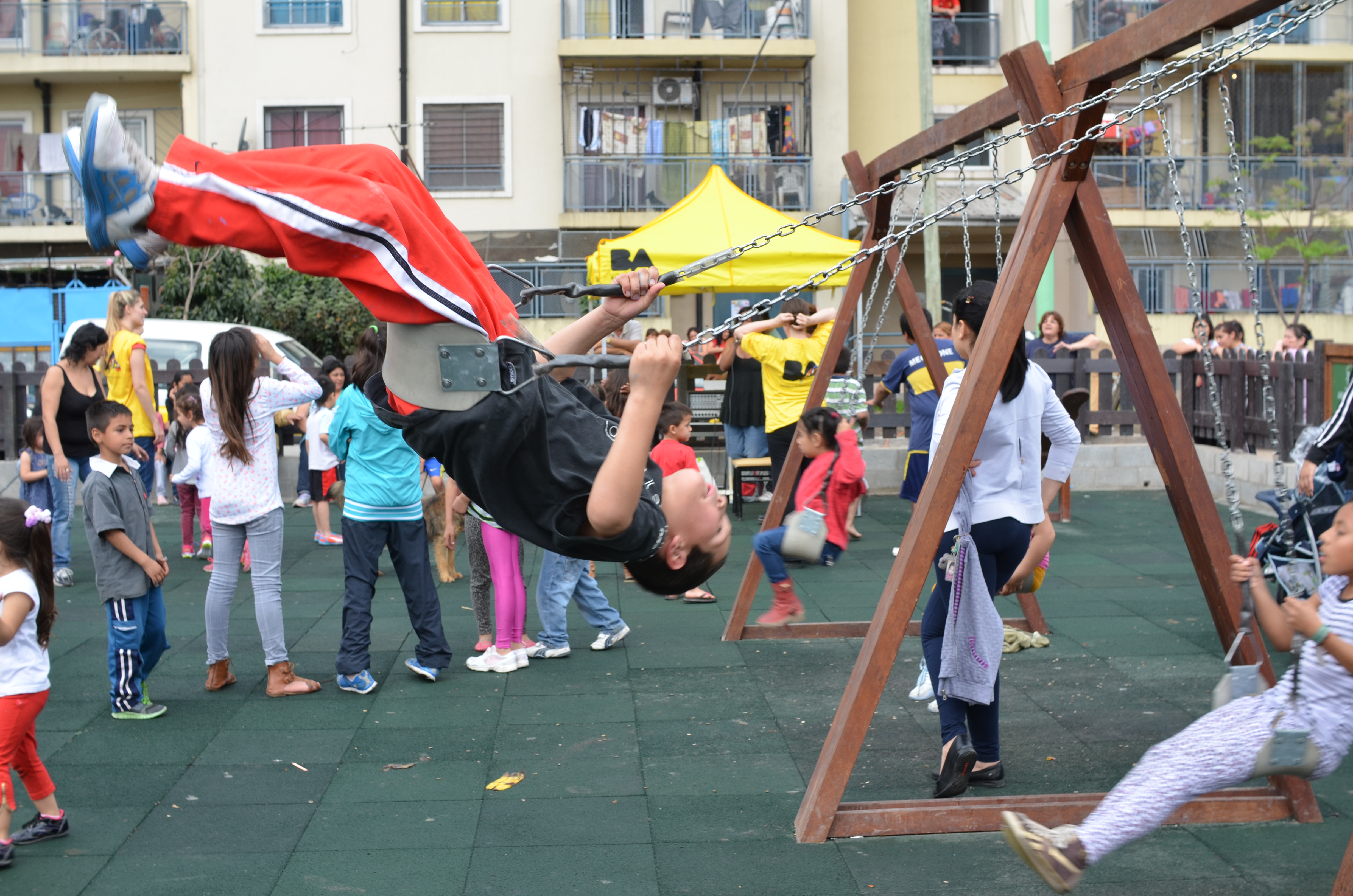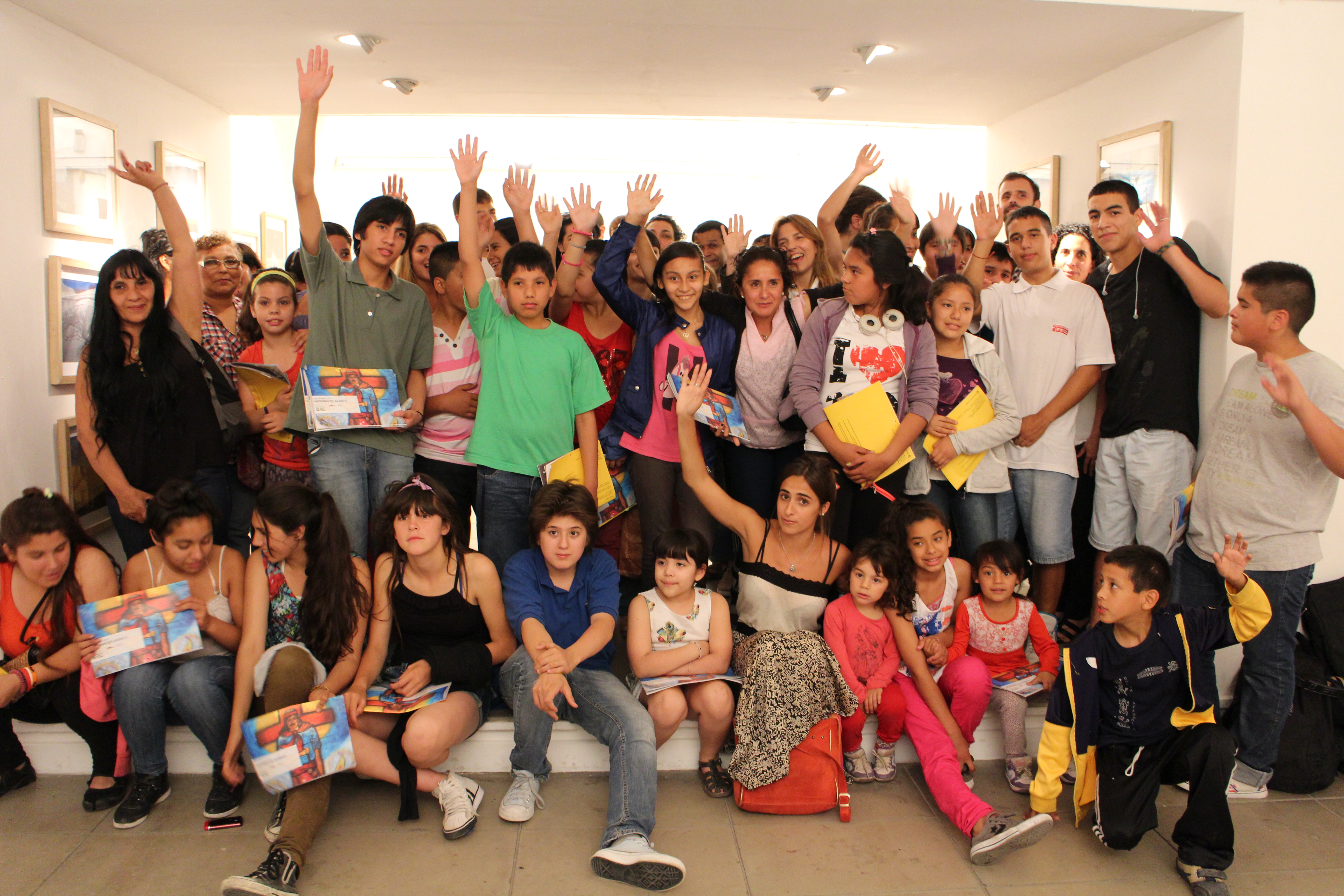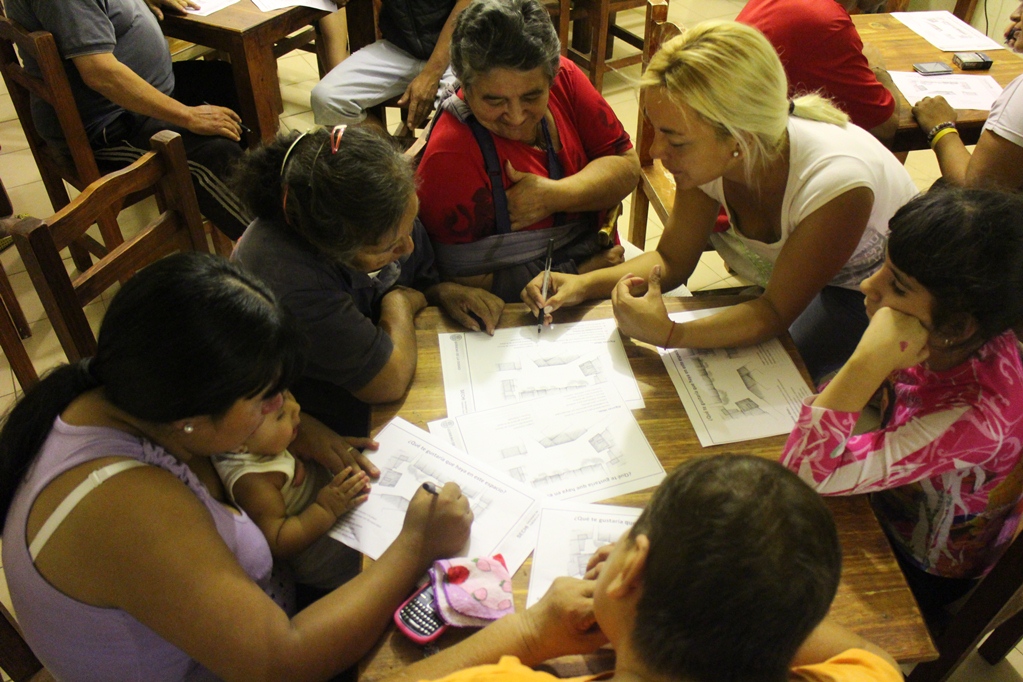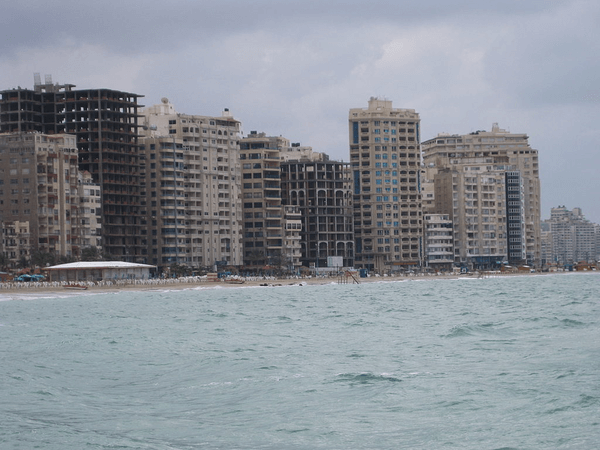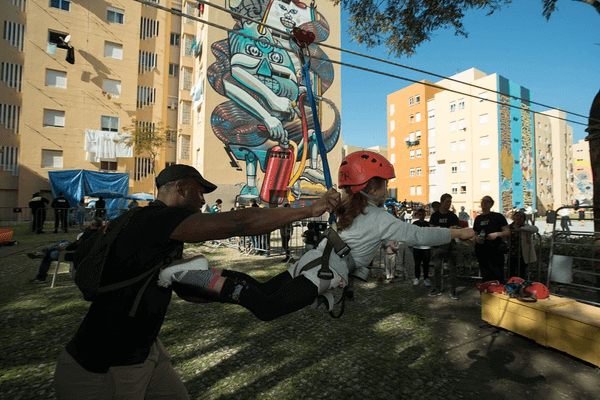 Social Management of Habitat at informal settlements, Buenos Aires (Ciudad), Argentina - © Secretaría de Hábitat e Inclusión
Social Management of Habitat at informal settlements, Buenos Aires (Ciudad), Argentina - © Secretaría de Hábitat e Inclusión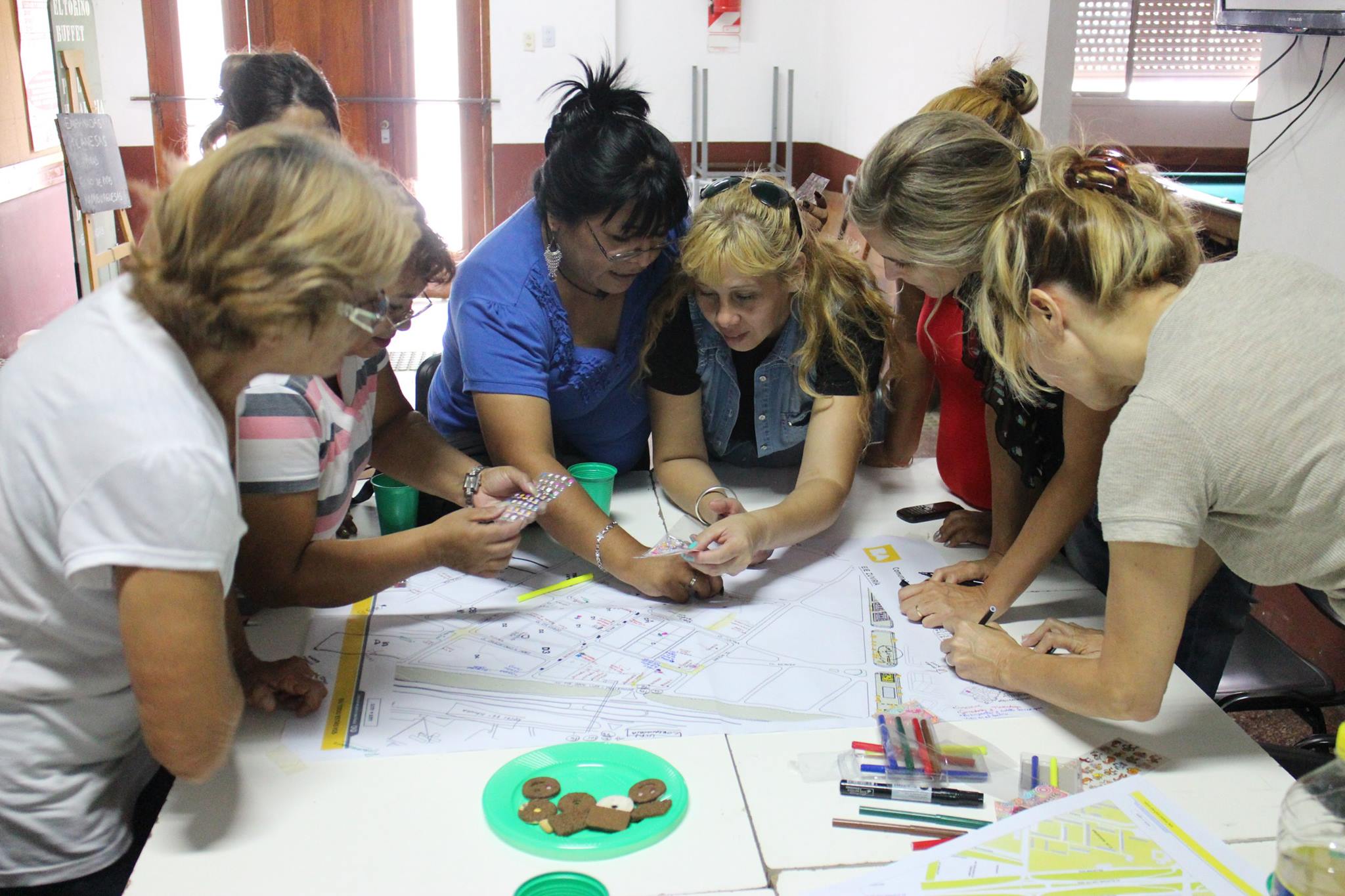 - © Secretaría de Hábitat e Inclusión
- © Secretaría de Hábitat e Inclusión- - © Secretaría de Hábitat e Inclusión
- - © Secretaría de Hábitat e Inclusión
- - © Secretaría de Hábitat e Inclusión
- - © Secretaría de Hábitat e Inclusión
City
Buenos Aires
Main actors
Local Government, Private Sector, NGO / Philanthropy, Community / Citizen Group
Project area
Metropolitan Area
Duration
Ongoing since 2011
In Buenos Aires, residents of informal neighbourhoods are encouraged to take an active role in the physical and social transformation of their own habitats.
The Secretariat for Habitat & Inclusion works under a paradigm for infrastructural and social interventions, one which considers the community as the protagonist in the physical and social transformation of its own habitat.
Under this social management model, the Secretariat works to generate stronger relationships between the State and informal neighbourhoods, helping to empower local institutions and develop public spaces for collective participation and decision-making.
Works are designed primarily to upgrade basic infrastructure, recover public spaces, and help to connect informal neighbourhoods with the rest of the City, with a view also to promoting mobility, accessibility and safety.
The Social Habitat Management project was a Metropolis Initiative for the period 2015-2017.
Dubai International Award for Best Practices
This project was awarded the 'Dubai International Award for Best Practices' in 2014.
The Secretariat of Habitat and Inclusion implements and coordinates urban and social integration strategies where the community plays a central role. It seeks to promote sustainable urban development through an integrated approach and to build an inclusive city through the design of physical and social architecture.
Objectives:
- Improve urban infrastructure and environmental health
- Build and recover public spaces
- Promote urban interconnectivity
- Promote social inclusion with a focus on gender perspective.
- Promote the regularization of properties
- Promote access to housing
- Generate territorial presence
The Social Management of Habitat is based on three pillars: territorial presence, social urbanism and inclusion from the perspective of the habitat.
Territorial Presence
Permanent territorial presence and day-to-day contact with local residents helps to strengthen the State’s links with local communities, and allows for more consensual and sustainable urbanisation processes.
Social Urbanism
Social urbanism is the practice of investing in social infrastructure - public works whose potential social benefits to the community are as strong as their infrastructural or economic benefits - and so helping to instill a sense of pride and belonging to one’s habitat.
Inclusion from the perspective of the habitat
Generating the necessary conditions for individuals to understand and take advantage of their rights, opportunities and duties as citizens – whether from a legal, social or cultural perspective - is absolutely fundamental to the processes of integration.
The provision of basic services includes works undertaken to upgrade basic infrastructure, improve utilities and sanitation, demarcate private and public spaces, support land-title regularisation and educate residents in proper usage and maintenance.
Urban acupuncture
Urban acupunctures are small-scale physical interventions designed to help transform the larger urban context. Here, the Secretariat places a strong emphasis on the recovery of public spaces, often lacking in overcrowded informal neighbourhoods, but nonetheless important spaces for socialisation and recreation, and often a source of pride and identity for the community. Works are defined and designed together with local residents. Civic pacts are signed between the government and the local community to reaffirm their joint commitment to the works, which typically involve the recovery, refurbishment and equipping of children’s playgrounds, sports fields and parks, plazas, streets and passageways. The Secretariat’s Directorate-General for Habitat offers architectural and technical expertise to support the decision-making and implementation process.
Urban connectors
Given the informal and unstructured growth of many of the neighbourhoods where the Secretariat for Habitat and Inclusion works, adequate mobility within the neighbourhood and connectivity with the rest of the City is often lacking. The Secretariat therefore place a strong focus on constructing better public transport arteries and street access, street lighting and signage, protected bicycle lanes and green spaces. Each work is accompanied by community education and inclusion activities to encourage usage and maintenance.
Our inclusion programmes are designed to break down the barriers hindering access to equal opportunities and promote important values and life skills. Together with civil society groups, and through consultation with local neighbours, the Secretariat’s Directorate-General for Inclusion coordinates umbrella programmes across all 7 Urban Inclusion Territorial Units, taking full advantage of public spaces as areas for recreation, education and participation. This top-down/bottom-up model is designed to empower local institutions and communities, generating in the long-term more independent, sustainable social capital and well-being in the communities themselves.
Citizenship & Living Together
Our objective for this programme is to transmit a proper understanding of individuals’ rights and obligations as citizens and as members of a community, with a view to encouraging greater participation and responsibility in decisions affecting the community, as well as a greater sense of one’s own economic and social potential. The Secretariat’s activities include running mentoring programmes for young entrepreneurs, equipping them with the tools and knowledge to develop their business ideas and holding local meetings to officially nominate and elect the names of public spaces.
The programme also helps strengthen channels of communication between the State and local residents.
Women & the Habitat
This programme has been developed to promote greater autonomy for women in informal neighbourhoods, strengthen the relationships between them, and help ensure that all our public works – from the design of a children’s playground, for example, to the installation of street lighting or public waste facilities – have a direct social benefit for local female residents. Our activities range from meetings to discuss, map out and respond to those aspects of everyday neighbourhood life which are most important for local women, to workshops on recycling and taking care of the environment, or on information for how to prevent domestic accidents.
Sports for Inclusion
It is well-recognised that sport, through its universality, transcends cultural, socio-economic and political barriers, and helps to transmit important life values, such as discipline, tolerance, respect, team-work and healthy lifestyles.
The Secretariat’s sports programmes are designed to give as many people as possible – particularly younger people - the opportunity to practice a range of sports, from tennis to taekwondo, and train and compete regularly as part of a team.
Together with the Under-Secretariat for Sport, we help bring professionals and sports celebrities to local neighbourhoods and we organise sporting events between different communities to encourage greater socialisation beyond the boundary of the neighbourhood.
Caring for Community Culture
Offering creative spaces for artistic expression and cultural appreciation, particularly in neighbourhoods with a diverse ethnic mix, is an important aspect of strengthening community diversity, cohesion and identity. Focusing on making ample use of public spaces, and together with members of the community, local non-for-profit groups and professional artists and entertainers, we help organise street festivals, circuses and musical concerts, offer artistic workshops for youngsters, and – taking advantage of the rich tradition of street art in Buenos Aires - run projects with professional artists and teenagers to design and paint public murals in the neighbourhood.
The lead agency for the project is the City of Buenos Aires and is administered by The Secretariat of Habitat and Inclusion. Financial support is provided by both the city and state government with contributions from private sector companies including Coca Cola, Fundación FEMSA of Mexico and Direct TV.
Programme stake holders include Argentina Tennis Association / School Model Football and Sports / Construction Workers Union of Argentina / Feriado amor al reciclado / Sumand Social Organization / Kine / Bombacova / Argentina Chess Federation Foundation.
In the context of METROPOLIS, the Social Habitat Management Project had the status of an Initiative (“a specific project or service carried out by and for cities in conjunction with businesses and institutions”) and received therefore an annual financial contribution from the network during the period 2015-2017.
The Social Habitat Management has achieved the following results:
Generation of territorial presence:
- 7 Urban Inclusion Territorial Units located in informal city areas
- 7 Resource Guides: providing contact information for organizations who offer social services in the 7 Urban Inclusion Territorial Units.
- 2 central government offices and 10 portals have been established throughout the territories and are staffed by multidisciplinary teams.
- 2 social meeting spaces where neighbours can engage with various sports and recreational activities.
2. Improvement of urban infrastructure and environmental health
10,500 linear meters of sewer and storm water infrastructure has been installed.
3. Generation and recovery of public spaces
90 spaces for social and collective use have been reclaimed for community use
4. Promotion of urban interconnectivity
The urban layout (streets, alleys, passages and corridors, etc.) in the villas and housing complexes has been redesigned to achieve greater integration with other districts and the city.
5. Promotion of social inclusion from the habitat perspective
The project has involved 152 organizations and impacted over 80,000 members of the community.
Case NGO “Fútbol para el Desarrollo” - Inclusive Sport Program: Implementation of street football for children and youth, a methodology based on strengthening positive values. In this type of football, men and women play together and there is no referee. Instead there is a space for dialogue between the teams before the match starts, where the players themselves set the rules. The game values not only amount of goals, but respect for those settled rules.
“Red Cross Argentina” Case - Women and Shelter Program: Training for young and adult women in accident prevention and first aid. The aim is to seek the understanding of the processes of health and disease in a broad context, which is closely related to the prevailing socio-economic conditions in each community.
Case Coca Cola FEMSA Company – Public-Private Management Association: Together with Fundación FEMSA of Mexico, the company participated through financial and technical cooperation in the installation of sewers and recovery of a place in the transitional housing centre Zavaleta. It had a very positive impact on the resolution of structural problems from the housing point of view, with high levels of conflict and unhealthy conditions.
Buenos Aires is a complex and fragmented city. The Secretariat for Habitat and Inclusion operates in the informal neighbourhoods housing people from different cultures, backgrounds and low socio-economic status which makes building relationships and consensus an on-going challenge.
Lesson 1: When building territorial teams for the physical and social transformation of neighbourhoods, it is important to incorporate staff from different disciplines, and include people that live in the neighbourhood as they can provide essential knowledge of the particulars of the community.
Lesson 2: Gender perspective is essential to achieve more inclusive physical and social change. From this learning, we implemented the program "Women in Everyday Urbanism" (under the Women and Habitat Program) in which we seek to gather women’s perception of their neighbourhoods and make them visible.
Lesson 3: It is essential to measure the impact of the project - social, physical, and institutional.
The services of Impact Economy have been employed to develop quantitative and qualitative indicators for each of our programs of inclusion and urban interventions.
Transfer of knowledge
The Social Habitat Management governance model has been shared at international events including the World Urban Forum 7 in Medellin (April 2014). In addition, the model has been shared at events hosted by Metropolis, CIDEU and Segib networks. The City of Buenos Aires has received visits by officials from the cities in Columbia, Chile, and Argentina, as well as international universities Oxford and Rice, to learn more about the programmes implemented as part of Social Management of Habitat.
- Exitosa iniciativa público-privada para hacer de una villa un barrio Website: Futuro Sustentable June 16, 2014 http://www.futurosustentable.com.ar/exitosa-iniciativa-publico-privada-para-hacer-de-una-villa-un-barrio/ Fecha: 15 de julio de 2014
- El resultado de la Responsabilidad Social Newspaper: Perfil June 29, 2014 Edición Impresa
- Todos juntos por un mismo fin Newspaper: BAE June 25, 2014 Edición Impresa
- Nueva Plaza Porteña Newspaper: El Cronista June 18, 2014 Edición Impresa
- Mejoramiento Barrial Newspaper: Tiempo Argentino June 16, 2014 Edición Impresa
- Intervención Zavaleta Newspaper: Mercado Online June 16,2014 http://www.mercado.com.ar/notas/protagonistas/8015735/intervencin-zavaleta
- Intervención Zavaleta, inclusión en un barrio del Sur de Buenos Aires Website: Unirse June 13, 2014 http://www.unirse.com.ar/2014/06/12/un-terreno-abandonado-fue-convertido-en-plaza-cancha-de-futbol-y-nuevo-acceso-al-barrio-del-sur-de-buenos-aires/
- Se inauguró la plaza los pibes de Zavaleta, una propuesta que nace gracias a la alianza público-privada Website: Área responsable June 13,2014 http://www.arearesponsable.com.ar/se-inauguro-la-plaza-los-pibes-de-zavaleta-una-propuesta-que-nace-gracias-a-la-alianza-publico-privada/
- Urbanización y Recreación para Zavaleta Website: Vision Sustentable June 13, 2014 http://www.visionsustentable.com.ar/blog/?p=7548
- Femsa, el gobierno porteño y una intervención virtuosa en Pompeya Junes 12, 2014 http://comunicarseweb.com.ar/?FEMSA%2C_el_Gobierno_Porteno_y_una_intervencion_virtuosa_en_Pompeya_&page=ampliada&id=12653&_s=&_page=
- Transforman barrio de Buenos Aires Oficial Web: FEMSA June 10, 2014 http://www.femsa.com/es/medios/transforman-fundaci%C3%B3n-femsa-y-coca-cola-femsa-barrio-de-buenos-aires
- El barrio Zavaleta tiene una nueva plaza y cloacas (The Zavaleta neighborhood has a new plaza and sewer) Newspaper: Clarín June 8, 2014 http://www.clarin.com/ciudades/barrio-Zavaleta-nueva-plaza-cloacas_0_1153085308.html
- UTIU, el proyecto del gobiernoporteño para urbanizarlas villas (Urban Inclusion Territorial Units, the Project of Buenos Aires City Government to urbanize villas) Newspaper: Clarín, architecture section June 2014 http://arq.clarin.com/urbano/plan-gobierno-porteno-urbanizar-villas_0_1159684435.html
- El mundial de futbol callejero: Inclusión Social y Deporte (Street football championship, inclusive sport program) TV Program: Futuro Posible June, 2014 http://youtu.be/8jpyMrPsso8
- Lectura Urbana B.A (Urban Lecture Buenos Aires) University Radio: Flacso Ecuador April, 2014 http://flacsoradio.ec/index.php/programas/academicos/poder-urbano/942-poder-urbano.html
- Levantan un centro social en la Villa 1-11-14 ( a social center is going to be built in villa 1-11-14) Newspaper: La Nación April 13, 2014 http://www.lanacion.com.ar/1680366-levantan-un-centro-social-en-la-villa-1-11-14
- La Ciudad propone romper el gueto de las villas para ganar inclusión (The City proposes to break villas ghetto to win inclusión) Newspaper: La Nación April 13, 2014 (at Medellin WUF7) http://www.lanacion.com.ar/1680365-la-ciudad-propone-romper-el-guetode-las-villas-para-ganar-inclusion
- Macri inauguró la sede del Banco Ciudad en Los Pïletones (Macriinaugurates City Bank office in Piletones) News portal: Nueva Ciudad December 10, 2012 https://dl.dropboxusercontent.com/u/59127549/Anexos%20Premio%20Onu%20H%C3%A1bitat%20-%20SECHI/Art%C3%ADculo%20de%20Prensa_1204%20Nueva%20Ciudad_Inauguraci%C3%B3n%20Banco%20Ciudad%20Los%20Piletones.jpg
- Klemensiewicz llevó el modelo de urbanización a Italia (SECHI in UN Habitat World Urbano Forum 6) News Agency: Tres Líneas September 6, 2012 https://dl.dropboxusercontent.com/u/59127549/Anexos%20Premio%20Onu%20H%C3%A1bitat%20-%20SECHI/Art%C3%ADculo%20de%20Prensa_0809%20Tres%20lineas_Participaci%C3%B3n%20en%20WUF%20Onu%20Habitat.jpg
- Queremos urbanizar la Villa 31 (Wewant to urbanize Villa 31) News Agency: ADN Noticias September 17, 2012 https://dl.dropboxusercontent.com/u/59127549/Anexos%20Premio%20Onu%20H%C3%A1bitat%20-%20SECHI/Art%C3%ADculo%20de%20Prensa_0918%20ADN_Urbanizaci%C3%B3n%20Villa%2031.jpg
- Inauguran el Primer Portal Inclusive (First SECHI office opened in Villa 1-11-14) Newspaper: La Nación June 16, 2012 https://dl.dropboxusercontent.com/u/59127549/Anexos%20Premio%20Onu%20H%C3%A1bitat%20-%20SECHI/Art%C3%ADculo%20de%20Prensa_06.2012_Diario%20LaNaci%C3%B3n_Inauguraci%C3%B3n%20Portal%20Inclusivo%20V.%201-11-14.jpg
External links / documents
On Map
The Map will be displayed after accepting cookie policy
